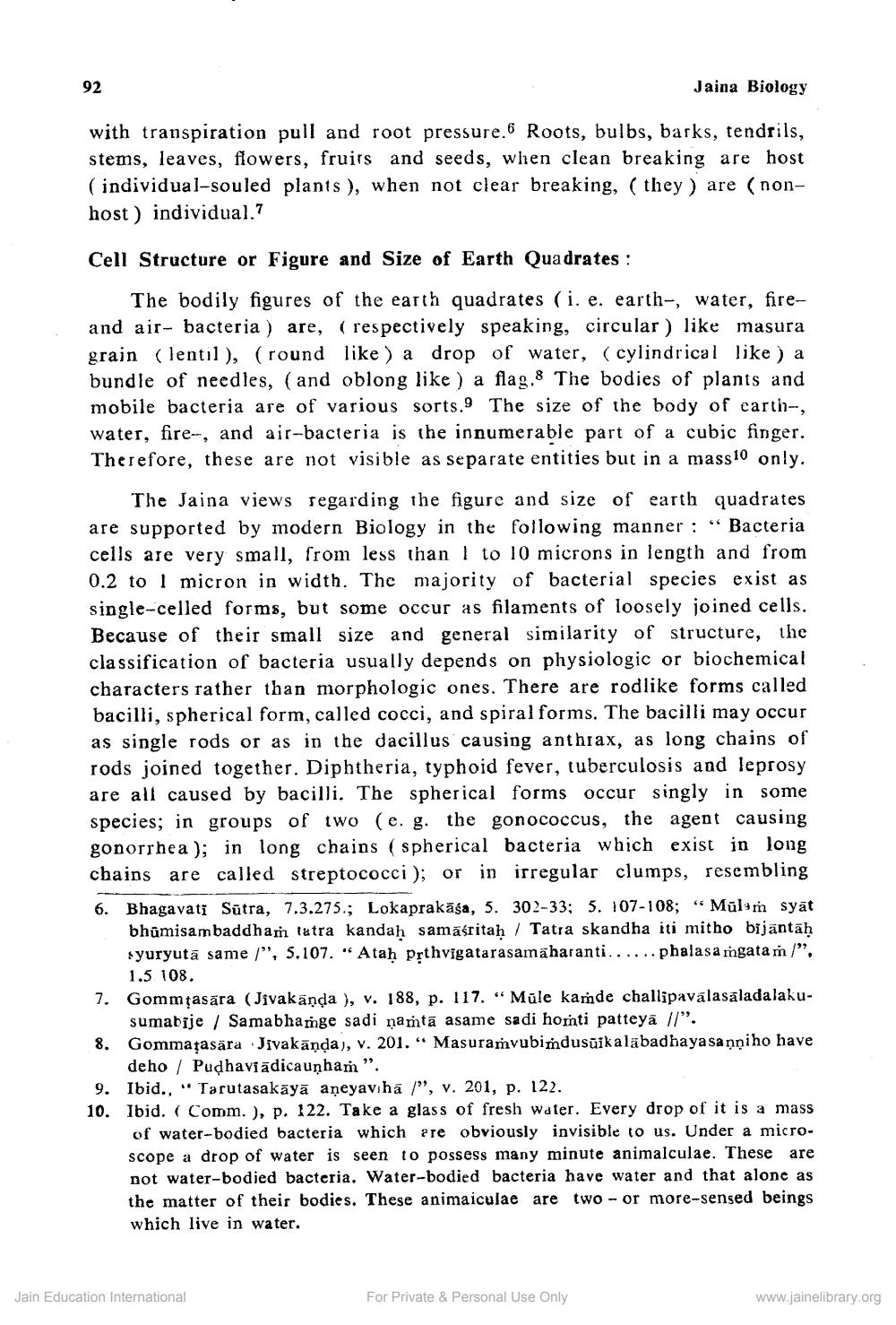________________
92
Jaina Biology
with transpiration pull and root pressure. Roots, bulbs, barks, tendrils, stems, leaves, flowers, fruits and seeds, when clean breaking are host (individual-souled plants ), when not clear breaking, (they ) are (nonhost) individual.7
Cell Structure or Figure and Size of Earth Quadrates :
The bodily figures of the earth quadrates (i. e. earth-, water, fireand air- bacteria ) are, (respectively speaking, circular) like masura grain (lentil), (round like ) a drop of water, (cylindrical like ) a bundle of needles, (and oblong like ) a flag. 8 The bodies of plants and mobile bacteria are of various sorts. The size of the body of carti, water, fire-, and air-bacteria is the innumerable part of a cubic finger. Therefore, these are not visible as separate entities but in a mass10 only.
The Jaina views regarding the figure and size of earth quadrates are supported by modern Biology in the following manner : " Bacteria cells are very small, from less than 1 to 10 microns in length and from 0.2 to 1 micron in width. The majority of bacterial species exist as single-celled forms, but some occur as filaments of loosely joined cells. Because of their small size and general similarity of structure, the classification of bacteria usually depends on physiologic or biochemical characters rather than morphologic ones. There are rodlike forms called bacilli, spherical form, called cocci, and spiral forms. The bacilli may occur as single rods or as in the dacillus causing anthrax, as long chains of rods joined together. Diphtheria, typhoid fever, tuberculosis and leprosy are all caused by bacilli. The spherical forms occur singly in some species; in groups of two (e. g. the gonococcus, the agent causing gonorrhea); in long chains ( spherical bacteria which exist in long chains are called streptococci ); or in irregular clumps, resembling 6. Bhagavati Sūtra, 7.3.275.; Lokaprakāśa, 5. 302-33; 5. 107-108; “Mūlym syāt
bhūmisambaddham tatra kandah samāśritan / Tatra skandha iti mitho bijantäh syuryutā same l”, 5.107. “Atah prthvigatarasamaharanti...... phalasa rngata m/", 1.5 108. Gommțasara (Jivakända ), v. 188, p. 117. “Müle kande challipavalasaladalakusumabije / Samabhamge sadi namtā asame sadi homti patteya 1/". Gommațasära Jivakānda), v. 201.“ Masuramvubimdusūikalabadhaya sanniho have
deho / Pudhaviādicaunham". 9. Ibid., " Tarutasakāyā aneyavha /", v. 201, p. 122. 10. Ibid. ( Comm.), p. 122. Take a glass of fresh water. Every drop of it is a mass
of water-bodied bacteria which are obviously invisible to us. Under a microscope a drop of water is seen to possess many minute animalculae. These are not water-bodied bacteria. Water-bodied bacteria have water and that alone as the matter of their bodies. These animaiculae are two - or more-sensed beings which live in water.
Jain Education International
For Private & Personal Use Only
www.jainelibrary.org




